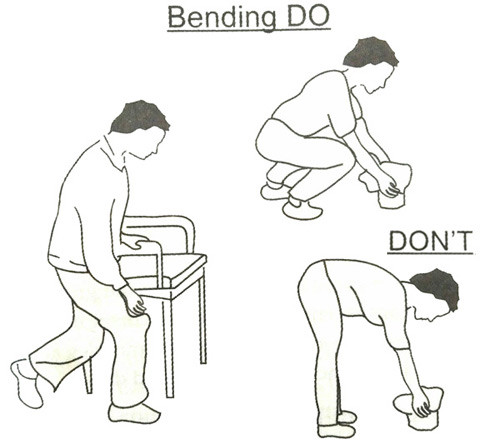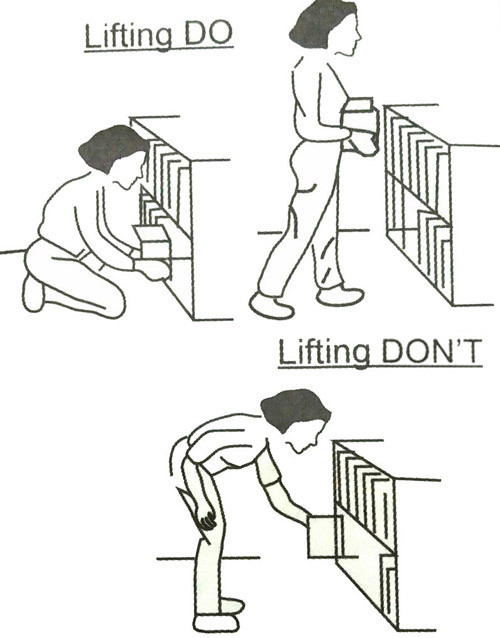It is worthwhile to observe farmers at work in the fields as they bend down, clearing weeds, planting seeds and doing more. Notice their backs as they toil. They bend for long hours without any problem because they maintain a forward bend by hinging at the hips and keep their backs flat through the bend. Strong muscles that create a central groove over the spine keep this laborious job from becoming a back-breaking affair.
The one action that can make or break even a strong back is a forward bend. Doctors confirm that behind most cases of backaches, there is a history of lifting some heavy object incorrectly. Does that mean that we should never bend forward? It is impossible to perform daily chores without these essential actions; we have to bend and straighten many times a day. So the question ought to be: ‘How should we bend forward?’
When bending forward, you must keep the following points in mind:
 Hinge at the hip
Hinge at the hip
A healthy forward bend involves a forward hinge at the hips with a straight lower back. The length of the back ought to be maintained all through the bend. Such a bend does not affect any disc anywhere in the spine. The discs remain decompressed and are not under any strain. A healthy bend at the hips is a beneficial exercise for the muscles of the back as they get a stretch. Such a bend brings muscles that run along the length of the spine into action. This keeps the back aligned rather than rounded. As these muscles strengthen, the hamstrings get a healthy stretch and tone.
Soft knees
We are taught to bend our knees to preserve our backs. This does preserve the back as it does not round. However, it stresses the knees and reduces the opportunity for the hamstrings to stretch. In general, you must avoid bending forward with the knees bent too much as this can put undue pressure on the knee joints. You can bend knees for lifting heavy objects or when the back is injured or in pain. Bent knees also facilitate a hinge at the hip for those with tight hamstrings. In such cases, tight hamstrings pull the sitting bones [to which they are attached] down. This forces the pelvis to tip backward. Bent knees ease the demand on the tight hamstrings and facilitate the hinge forward at the hips.
How to move when you bend forward and come up?
 In the beginning, a correct forward bend requires concentration and slow motion. With time, it becomes an automatic process. Practise the following method a few times to get a feel of the ideal mechanism of bending forward and coming up.
In the beginning, a correct forward bend requires concentration and slow motion. With time, it becomes an automatic process. Practise the following method a few times to get a feel of the ideal mechanism of bending forward and coming up.
- Stand with the feet parallel at hip-width distance. If the forward bend is deep, you can place your feet wider apart.
- Place the fingertips of one of your hands in the midline groove of your lower back. This is to monitor the bend.
- Place the edge [little finger side] of your other hand in the crease or the fold between the torso and the thigh. When you bend, feel the hinging on the hip joint on this hand.
- Unlock your knees and keep them soft. You can bend them as necessary to accommodate the tightness of your hamstrings.
- Start the bend from the hip joints. Feel your pelvis come forward as your back follows it.
- The fingertips of the hand on your lower back should not feel any change in the midline groove. If the groove begins to disappear or if it becomes deeper, straighten up a bit and proceed again.
- If the hamstring muscles behind the thighs and the knees are tight, the lower back groove tends to disappear. To preserve the shape of the back, you will have to bend your knees. The bend at the knees should be smooth and not jerky. It should be coordinated with the hip hinge. The knees should not turn inward [they should not go close to each other]. The knees should point in the same direction as the feet.
- If the lower back groove begins to deepen, it reflects that the abdominals are weak and lax. The muscles along the length of the back begin to over-contract to deepen the groove. In such a case, remember to engage your inner corset and come up. Restart the forward bend with your core muscles activated to support your lower back from being pulled down.
- For the safety of the neck, do not allow your neck to protrude forward. Imagine that your neck is an extension of the spine and keep it aligned with the head, the neck and the shoulders in the same manner as you would when you stand.
- When you are ready to come up, engage your inner corset and start unhinging at the hip joints so that the trunk moves up along with the pelvis. The groove in the back should remain the same.
Backaches related to forward bends
If the lower back hurts when you bend forward, it means that the back muscles are in a state of spasm. Forward bends stretch the back muscles, making the back round. This leads to pain. To keep the back supported and the lower spine discs safe, observe these safeguards:
- Navel in: Engage your inner corset before you begin to bend. This helps to maintain the torso as a single unit.
- Gentle bend at the knees: If the back still hurts, start with a small bend in the knees along with the inner core tone. Practise lower back stretches and abdominal strengthening exercises regularly.
- In case of an acute prolapsed disc, take rest to relax the back muscles and follow the doctor’s advice. Apply these principles once you have been advised to resume normal activities.
Lifting heavy objects
 Lifting heavy objects exerts further pressure on the joints of the spine. It is estimated that lifting a 12 kg weight with bent knees and a straight back puts around 140 kg of force on the bones of the spine. If the same weight is lifted with straight knees and bending from the waist, the force exerted on the back gets almost doubled. You can save your back all this anguish.
Lifting heavy objects exerts further pressure on the joints of the spine. It is estimated that lifting a 12 kg weight with bent knees and a straight back puts around 140 kg of force on the bones of the spine. If the same weight is lifted with straight knees and bending from the waist, the force exerted on the back gets almost doubled. You can save your back all this anguish.
- Assess the load and its weight by pushing it with your foot. If it is too heavy, ask someone for help.
- Avoid bending and lifting anything first thing in the morning as one is more vulnerable to disc injury at that time.
- Go close to the load. The closer we are to the object, the lesser is the strain on the joints. The weight evenly distributes over the spine, the pelvis and the legs. Also, you are less likely to lose balance and fall. The pressure on the back increases when the distance from the object increases.
- Face the object. Do not venture to lift objects when the body is twisted. Most injuries caused while lifting objects occur when the spine is twisted. The remedy is to face the load before we lift the object. Lifting sideways is a definite ‘NO’.
- Before the lift, tighten the abdominal muscles as much as you can. This accords a firm support to the lower back. So, take a deep breath and pull the navel in as much as you can, as if you are zipping up a pair of tight-fit trousers. Keep the abdominals drawn in when you lift or put the weight down. However, do not forget to breathe simultaneously!
- Do not bend from the waist. Bend the knees and the hips. This allows the larger muscles of the legs to work. If you bend from the waist to lift objects, the back muscles have to work twice as hard to do the job. In addition, if they are already compromised, the pressure gets transmitted to the discs – a dangerous proposition.
- Pick the load and bring it in close to the body. Push the ground firmly with both your feet as you straighten your legs.
- If you need to carry the load, keep the stomach muscles tight as you breathe.
- Maintain a neutral spine.
- As you carry the object, hold it as close to the body as possible. Again, the closer the object to the body, the lesser the strain on the spine and the muscles.
- Never raise a heavy object above the waist level.
- If you need to turn, do not twist at the waist with the object in your hands. Instead, turn your feet with small steps to turn the body.
- To lower the load, again bend your knees and hips. Stick the buttocks behind as you go down.
Adapted with permission from The Power Of Posture by Renu Mahtani; Published by Jaico Books
